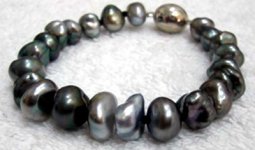P
Pearlgully
Guest
How do you measure the mm size of a keshi pearl; end to end or widest part of the middle?
Just curious, is it unusual for keshi pearls to be drilled through the middle (as in the bracelet) as opposed to end to end? Was this a design decision or was there some other reason.
Gail
Just curious, is it unusual for keshi pearls to be drilled through the middle (as in the bracelet) as opposed to end to end? Was this a design decision or was there some other reason.
Gail

